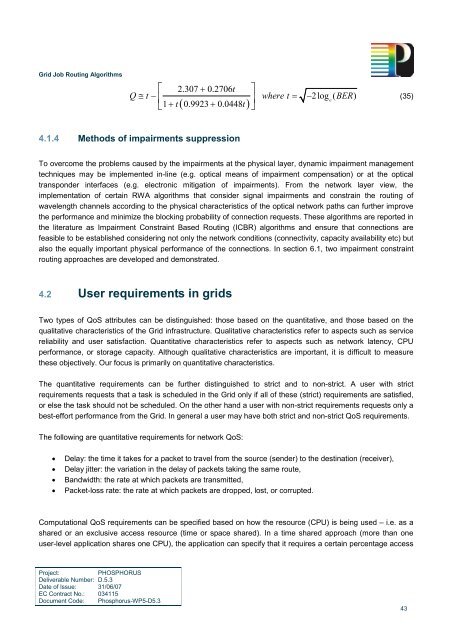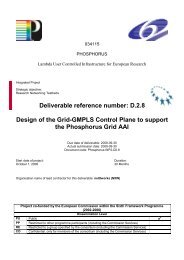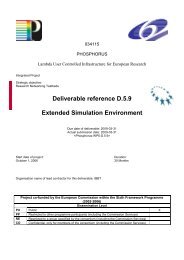Grid Job Routing Algorithms - Phosphorus
Grid Job Routing Algorithms - Phosphorus
Grid Job Routing Algorithms - Phosphorus
You also want an ePaper? Increase the reach of your titles
YUMPU automatically turns print PDFs into web optimized ePapers that Google loves.
<strong>Grid</strong> <strong>Job</strong> <strong>Routing</strong> <strong>Algorithms</strong>⎡2.307 + 0.2706tQ ≅ t − ⎢⎥ where t = −2log ( BER)e1 + t 0.9923 + 0.0448⎣( t)⎤⎦(35)4.1.4 Methods of impairments suppressionTo overcome the problems caused by the impairments at the physical layer, dynamic impairment managementtechniques may be implemented in-line (e.g. optical means of impairment compensation) or at the opticaltransponder interfaces (e.g. electronic mitigation of impairments). From the network layer view, theimplementation of certain RWA algorithms that consider signal impairments and constrain the routing ofwavelength channels according to the physical characteristics of the optical network paths can further improvethe performance and minimize the blocking probability of connection requests. These algorithms are reported inthe literature as Impairment Constraint Based <strong>Routing</strong> (ICBR) algorithms and ensure that connections arefeasible to be established considering not only the network conditions (connectivity, capacity availability etc) butalso the equally important physical performance of the connections. In section 6.1, two impairment constraintrouting approaches are developed and demonstrated.4.2 User requirements in gridsTwo types of QoS attributes can be distinguished: those based on the quantitative, and those based on thequalitative characteristics of the <strong>Grid</strong> infrastructure. Qualitative characteristics refer to aspects such as servicereliability and user satisfaction. Quantitative characteristics refer to aspects such as network latency, CPUperformance, or storage capacity. Although qualitative characteristics are important, it is difficult to measurethese objectively. Our focus is primarily on quantitative characteristics.The quantitative requirements can be further distinguished to strict and to non-strict. A user with strictrequirements requests that a task is scheduled in the <strong>Grid</strong> only if all of these (strict) requirements are satisfied,or else the task should not be scheduled. On the other hand a user with non-strict requirements requests only abest-effort performance from the <strong>Grid</strong>. In general a user may have both strict and non-strict QoS requirements.The following are quantitative requirements for network QoS:• Delay: the time it takes for a packet to travel from the source (sender) to the destination (receiver),• Delay jitter: the variation in the delay of packets taking the same route,• Bandwidth: the rate at which packets are transmitted,• Packet-loss rate: the rate at which packets are dropped, lost, or corrupted.Computational QoS requirements can be specified based on how the resource (CPU) is being used – i.e. as ashared or an exclusive access resource (time or space shared). In a time shared approach (more than oneuser-level application shares one CPU), the application can specify that it requires a certain percentage accessProject:PHOSPHORUSDeliverable Number: D.5.3Date of Issue: 31/06/07EC Contract No.: 034115Document Code: <strong>Phosphorus</strong>-WP5-D5.343






